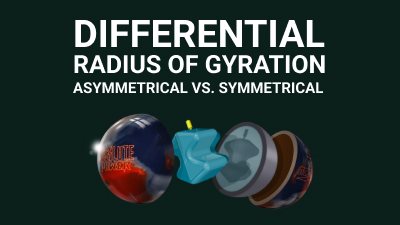Bowling, a sport beloved by millions around the world, often seems straightforward: roll a ball down a lane and knock down pins. However, behind this apparent simplicity lies a fascinating world of physics and engineering, particularly when it comes to the mechanics of the bowling ball itself. For beginners eager to delve deeper into the sport, understanding concepts like Radius of Gyration (RG) and Differential, as well as the distinction between asymmetrical and symmetrical balls, can be pivotal.
Unraveling the Mysteries of RG and Differential
Imagine spinning a top. As it spins, the distance between its center of mass and its axis of rotation influences how stable it remains. This distance, analogous to the RG of a bowling ball, determines how easily the ball transitions into a roll. A low RG ball will rev up quickly and roll smoothly, ideal for heavy oil conditions or when you need early hook potential. Conversely, a high RG ball delays its revving, offering more length and angular motion down the lane, suitable for drier conditions.
Differential, on the other hand, measures the variation in RG across the ball's axis. Think of it as the ball's ability to change direction. A high differential ball will create a sharper angle of entry into the pins, maximizing pin action and increasing the likelihood of strikes, especially on medium to heavy oil patterns. Meanwhile, a low differential ball tends to have a more predictable, controlled motion, making it suitable for straighter angles or lighter oil conditions.
The Symmetry Spectrum: Asymmetrical vs. Symmetrical
Bowling balls come in two primary forms: symmetrical and asymmetrical. Imagine symmetrical balls as perfectly balanced spheres, their RG values consistent across all axes. These balls offer a smooth, predictable roll, making them excellent choices for beginners or when facing less challenging lane conditions.
Conversely, asymmetrical balls boast varying RG values along different axes. Picture a figure skater executing a spin with outstretched arms. When they bring their arms closer to their body, they spin faster due to a decrease in their moment of inertia. Similarly, asymmetrical balls, with their varied RG values, generate more angular motion and backend reaction, ideal for navigating tricky lane conditions or for bowlers seeking greater hook potential.
Choosing Your Arsenal: Finding the Right Ball for You
Selecting the ideal bowling ball involves understanding your playing style, lane conditions, and desired ball reaction. For beginners, starting with a symmetrical ball with a moderate RG and differential can provide a stable foundation for learning proper technique and control. As your skills progress and you encounter diverse lane conditions, exploring asymmetrical options with varying RG and differential values allows for greater adaptability and versatility in your game.
In conclusion, mastering the mechanics of a bowling ball, from RG and differential to the choice between symmetrical and asymmetrical designs, opens doors to a deeper understanding of the sport and enhances your performance on the lanes. Like a craftsman selecting the perfect tool for the job, choosing the right bowling ball tailored to your playing style and the conditions at hand can make all the difference between a spare and a strike. So, next time you step onto the approach, remember the science behind the roll and unleash the power of precision and strategy in your game.
For more tips and tricks to better your bowling game, head over to Bowling 101 where you have access to many educational bowling videos





.jpeg)
